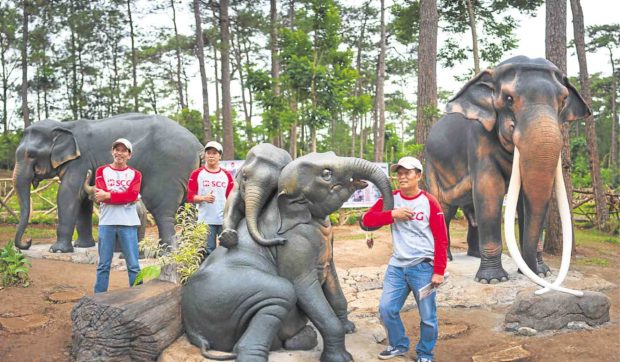
GIFT FROM THAILAND Elephant sculptures at Baguio Botanical Garden, created by these Thai artists, symbolize the friendship between the Philippines and Thailand. —RICHARD BALONGLONG
BAGUIO CITY — Elephant statues donated by the government of Thailand have been installed at a city park, which used to keep a menagerie of animals in the 1950s and the early 1960s.
Thai officials on Monday turned over the five elephant statues at Baguio Botanical and Zoological Garden, which once served as a zoo.
Established in 1956 during the administration of President Ramon Magsaysay, the former garden used to be filled with cages that housed monkeys, crocodiles, bears, lions, tigers and a couple of elephants, which took enormous amounts of public money to feed, said Cordelia Lacsamana, city environment and parks management officer.
The elephant is sacred to Thailand and the sculptures must be appreciated for the value their donors give to these animals, she said.
“We hope they would bring power to Baguio City,” said Ambassador Thanatip Upatising of the Royal Thai Embassy during the turnover ceremony.
He said elephants were “big and strong but gentle” and family-oriented, which, he noted, was “a characteristic that we want to encourage everyone to adapt.”
Upatising said the five elephants were crafted in time for the 70th celebration of diplomatic relations between the Philippines and Thailand in 2019.
The elephant replicas were sculpted by Thai artists Somphong Boonthip, Prasan Pransatketkam and Natithivat Khantharankham. It took them four months to finish all five statues.
Local records do not explain why Baguio decided to start a zoo or where the animals originated.
But the city government undertook projects to bring tourists to a rebuilt Baguio, which was flattened by American bombers at the end of World War II in 1945.
On April 9, 1949, the city hosted a Baguio Exposition and Carnival advocated by Virginia de Guia, then the acting mayor and city councilor.
Lions and elephants shipped in by Kamala Circus of India paraded along downtown Session Road, according to one account.
But Baguio-born residents aged below 50 barely remembered the animals kept at the botanical garden, except for an aviary and the monkey cages that were still around before the 1970s, Lacsamana said.
“We had reindeer in the park … we had ducks, we had pythons. I saw these animals back in grade school in the 1960s … when we had school picnics, these were usually held at the botanical garden,” she said. —Vincent Cabreza and Kimberlie Quitasol

